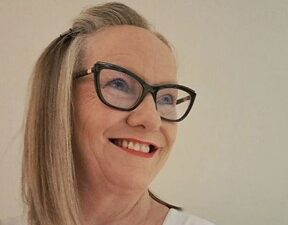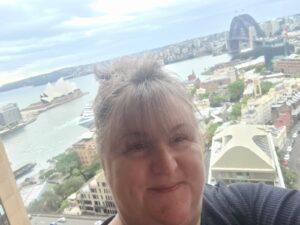My neuroendocrine tumour (NET) story begins in the year 2000 when I was in my twenties.
I was diagnosed with a low-grade pancreatic NET because I was having stomach pains. First off, the GP thought it was me being blocked up, but stomach pains persisted, and I had an ultrasound and then a CT scan that confirmed a pancreatic NET. I had a biopsy that confirmed it was low-grade and that I would require a large surgery called a Whipple’s Procedure. I had this done at Mount Hospital in Perth in March 2000.
It was an almost 8-hour operation, and I was in the ICU for a couple of days and in hospital for between two to three weeks.
I had regular scans over the years – octreotide and CT scans and all was fine. Then, in June 2019, I started having stomach pains again. I ended up in the emergency department and they told me I was constipated, despite them knowing I had a history of pancreatic NET. Luckily, I have an excellent GP and she ordered a CT scan that showed up a possible NET near the superior mesenteric artery.
I saw the original surgeon who performed the Whipple’s surgery, and he ordered an endoscopic ultrasound and biopsy that confirmed it was a low-grade pancreatic NET. Unfortunately, it not operable this time around.
The surgeon referred me to the amazing multidisciplinary team at Fiona Stanley Hospital (FSH). I saw an oncologist, surgeon and had a Gallium-68 PET scan, other tests and blood tests and in September 2019, I began having monthly lanreotide injections.
In December 2019, the Gallium-68 PET scan picked up an early-stage HER-2 Positive breast cancer in my right breast. This was nothing to do with my NET, but I was extremely fortunate that the PET scan had picked it up.
I saw the breast cancer team at FSH and attended many appointments at the Breast Clinic at FSH. In early February 2020, I had a lumpectomy, then I had three months of chemotherapy and then six weeks of radiation. This was all when covid was starting – but I thought at least I am able to get out of the house – to visit the hospital!! FSH literally became my second home!!
I was still having the monthly Lanreotide injections for the NET and follow up appointments with the oncologist.
The Breast Clinic at FSH was amazing – they were so helpful and had many resources, including a multitude of pamphlets on other support services, a free bra and regular appointments at the clinic. They really supported me throughout the whole breast cancer surgery and treatment. I lost my hair from the chemotherapy and the Breast Clinic gave me resources to get head coverings and see a psychologist through the Breast Clinic.
It felt very strange having concurrent (unrelated) cancers and I noticed the difference in resources for breast cancer compared to NETS. Fortunately, at the Cancer Centre at FSH they had a pamphlet on the Unicorn Foundation (now NeuroEndocrine Cancer Australia (NECA)), and they were super helpful and supportive. I spoke to the NECA nurse who was very understanding and helpful and I attended some support group meetings when I was feeling well enough. I realised that NETS really requires more funding and compared to the Breast Clinic at FSH, with all their resources, NET patients really do miss out! Luckily, I have an incredible multidisciplinary NETS team at FSH, and they have been super comforting and supportive throughout my NETS experience.
In mid-2020, the PET scan showed spread of the NET to segment 4 of the liver and the primary tumour had increased slightly in size. This then required surgery (which I was so grateful to be able to have) and in July 2020, I had liver surgery at Hollywood Hospital. This was also the last day of my radiation treatment for the breast cancer. I had to be at the radiation place at FSH at 7.30am and at Hollywood Hospital by 11.30am.
The liver surgery went well, and I was in hospital for about eight days. As uncomfortable as it was recovering from the surgery, I was grateful that it was an option for me.
After the surgery, I continued having monthly Lanreotide injections for the rest of 2020 and all of 2021. Unfortunately, in December 2021, the PET scan showed the NET had spread to segment 7 of the liver and the primary was slightly larger.
The oncologist referred me to the nuclear medicine department of FSH to start Peptide Receptor Radionuclide Therapy (PRRT). I was stopping the Lanreotide injections because they were not helping and the oncologist was disappointed the NET had spread again to the liver, despite having the liver surgery only 18 months previously.
At the end of January 2022, I started PRRT. I was having four infusions, eight weeks apart. The first infusion knocked me around a lot, but it was not as bad as the breast cancer chemotherapy. I finished PRRT end of July 2022, but did not start getting my normal energy levels back until end of October 2022.
This year, 2023, is the first time since June 2019, I have not been having some sort of active cancer treatment at the hospital!
I am on Tamoxifen tablets for the breast cancer, have yearly mammograms and breast ultrasounds and six-monthly PET scans for the NET, plus blood tests and regular check-ups with my GP. I see the oncologists at FSH, and I still see a psychologist.
Living with NETS has been challenging but I am so grateful for each day and feel super lucky to have a very supportive network of people, including family, friends, work colleagues and NECA WA Support Group. I just wish that NET patients had the resources available to other cancer patients, such as breast cancer patients, and there was more awareness about NETS, because is so individual and is so often misdiagnosed.





